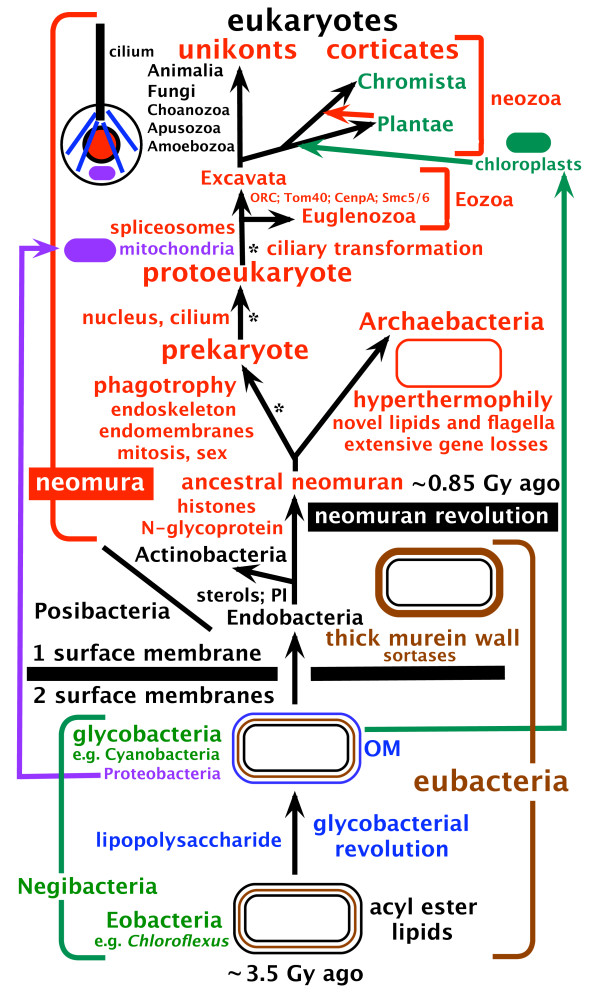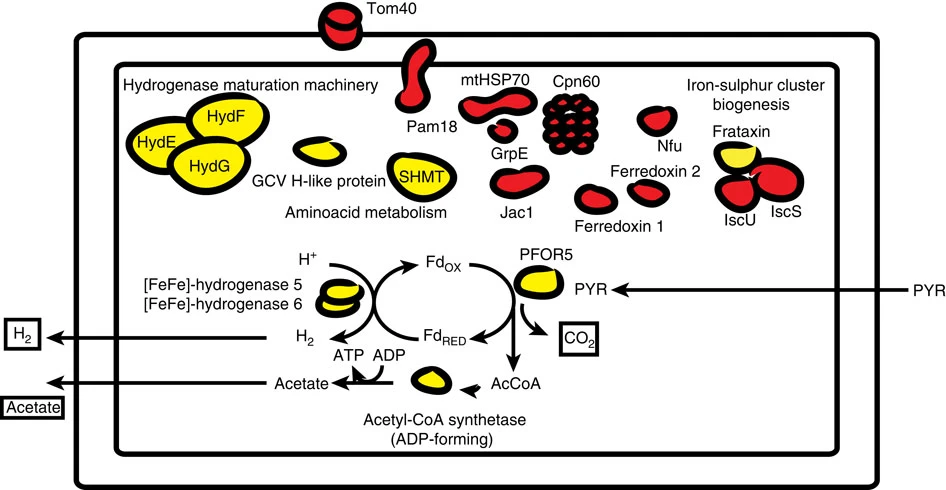|
Archezoa
In biology, Archezoa is a term that has been introduced by several authors to refer to a group of organisms (a taxon). Authors include Josef Anton Maximilian Perty, Ernst Haeckel and in the 20th century by Thomas Cavalier-Smith in his classification system. Each author used the name to refer to different arrays of organisms. This reuse by later authors of the same taxon name for different groups of organisms is widely criticized in taxonomy because the inclusion of the name in a sentence (e.g. "Archezoa have no olfactory organs") does not make sense unless the particular usage is specified (e.g. "Archezoa ''sensu'' Cavalier-Smith (1987) have no olfactory organs"). Nonetheless, all uses of 'Archezoa' are now obsolete. Archezoa ''sensu'' Cavalier-Smith (1987) Cavalier-Smith proposed the term 'Archezoa' for a paraphyletic (see Paraphyly) territory of eukaryotes that primitively lacked mitochondria. Like Margulis and others before (see Pelomyxa), Cavalier-Smith argued that the i ... [...More Info...] [...Related Items...] OR: [Wikipedia] [Google] [Baidu] |
Cavalier-Smith's System Of Classification
The initial version of a classification system of life by British zoologist Thomas Cavalier-Smith appeared in 1978. This initial system continued to be modified in subsequent versions that were published until he died in 2021. As with classifications of others, such as Carl Linnaeus, Ernst Haeckel, Robert Whittaker (ecologist), Robert Whittaker, and Carl Woese, Cavalier-Smith's classification attempts to incorporate the latest developments in taxonomy., Cavalier-Smith used his classifications to convey his opinions about the evolutionary relationships among various organisms, principally microbial. His classifications complemented his ideas communicated in scientific publications, talks, and diagrams. Different iterations might have a wider or narrow scope, include different groupings, provide greater or lesser detail, and place groups in different arrangements as his thinking changed. His classifications has been a major influence in the modern taxonomy, particularly of protists. ... [...More Info...] [...Related Items...] OR: [Wikipedia] [Google] [Baidu] |
Thomas Cavalier-Smith
Thomas (Tom) Cavalier-Smith, FRS, FRSC, NERC Professorial Fellow (21 October 1942 – 19 March 2021), was a professor of evolutionary biology in the Department of Zoology, at the University of Oxford. His research has led to discovery of a number of unicellular organisms (protists) and advocated for a variety of major taxonomic groups, such as the Chromista, Chromalveolata, Opisthokonta, Rhizaria, and Excavata. He was known for his systems of classification of all organisms. Life and career Cavalier-Smith was born on 21 October 1942 in London. His parents were Mary Maude (née Bratt) and Alan Hailes Spencer Cavalier Smith. He was educated at Norwich School, Gonville and Caius College, Cambridge (MA) in Biology and King's College London (PhD) in Zoology. He was under the supervision of Sir John Randall for his PhD thesis between 1964 and 1967; his thesis was entitled "''Organelle Development in'' Chlamydomonas reinhardii". From 1967 to 1969, Cavalier-S ... [...More Info...] [...Related Items...] OR: [Wikipedia] [Google] [Baidu] |
Pelomyxa
''Pelomyxa'' is a genus of giant flagellar amoebae, usually 500–800 μm but occasionally up to 5 mm in length, found in anaerobic or microaerobic bottom sediments of stagnant freshwater ponds or slow-moving streams.Chistyakova, L. V., and A. O. Frolov. "Light and electron microscopic study of Pelomyxa stagnalis sp. n.(Archamoebae, pelobiontida)." Cell and Tissue Biology 5.1 (2011): 90-97. The genus was created by R. Greeff, in 1874, with ''Pelomyxa palustris'' as its type species. In the decades following the erection of ''Pelomyxa'', researchers assigned numerous new species to it. However, in the last quarter of the 20th century, investigators reduced the genus to a single species, ''Pelomyxa palustris'', which was understood to be a highly changeable organism with a complex life cycle, whose various phases had been mistaken for separate species. All described species were relegated to the status of synonyms, or moved to the unrelated genus ''Chaos''. Since 2004, fo ... [...More Info...] [...Related Items...] OR: [Wikipedia] [Google] [Baidu] |
Microsporidia
Microsporidia are a group of spore-forming unicellular parasites. These spores contain an extrusion apparatus that has a coiled polar tube ending in an anchoring disc at the apical part of the spore.Franzen, C. (2005). How do Microsporidia invade cells?. Folia Parasitologica, 52(1–2), 36–40. doi.org/10.14411/fp.2005.005 They were once considered protozoans or protists, but are now known to be fungi, or a sister group to true fungi. These fungal microbes are obligate eukaryotic parasites that use a unique mechanism to infect host cells. They have recently been discovered in a 2017 Cornell study to infect Coleoptera (beetles) on a large scale. So far, about 1500 of the probably more than one million species are named. Microsporidia are restricted to animal hosts, and all major groups of animals host microsporidia. Most infect insects, but they are also responsible for common diseases of crustaceans and fish. The named species of microsporidia usually infect one host species ... [...More Info...] [...Related Items...] OR: [Wikipedia] [Google] [Baidu] |
Eukaryote
The eukaryotes ( ) constitute the Domain (biology), domain of Eukaryota or Eukarya, organisms whose Cell (biology), cells have a membrane-bound cell nucleus, nucleus. All animals, plants, Fungus, fungi, seaweeds, and many unicellular organisms are eukaryotes. They constitute a major group of Outline of life forms, life forms alongside the two groups of prokaryotes: the Bacteria and the Archaea. Eukaryotes represent a small minority of the number of organisms, but given their generally much larger size, their collective global biomass is much larger than that of prokaryotes. The eukaryotes emerged within the archaeal Kingdom (biology), kingdom Asgard (Archaea), Promethearchaeati and its sole phylum Promethearchaeota. This implies that there are only Two-domain system, two domains of life, Bacteria and Archaea, with eukaryotes incorporated among the Archaea. Eukaryotes first emerged during the Paleoproterozoic, likely as Flagellated cell, flagellated cells. The leading evolutiona ... [...More Info...] [...Related Items...] OR: [Wikipedia] [Google] [Baidu] |
Biological Hypotheses
Biology is the scientific study of life and living organisms. It is a broad natural science that encompasses a wide range of fields and unifying principles that explain the structure, function, growth, origin, evolution, and distribution of life. Central to biology are five fundamental themes: the cell as the basic unit of life, genes and heredity as the basis of inheritance, evolution as the driver of biological diversity, energy transformation for sustaining life processes, and the maintenance of internal stability (homeostasis). Biology examines life across multiple levels of organization, from molecules and cells to organisms, populations, and ecosystems. Subdisciplines include molecular biology, physiology, ecology, evolutionary biology, developmental biology, and systematics, among others. Each of these fields applies a range of methods to investigate biological phenomena, including scientific method, observation, experimentation, and mathematical modeling. Modern bio ... [...More Info...] [...Related Items...] OR: [Wikipedia] [Google] [Baidu] |
Obsolete Eukaryote Taxa
Obsolescence is the process of becoming antiquated, out of date, old-fashioned, no longer in general use, or no longer useful, or the condition of being in such a state. When used in a biological sense, it means imperfect or rudimentary when compared with the corresponding part of other organisms. The international standard IEC 62402:2019 Obsolescence Management defines obsolescence as the "transition from available to unavailable from the manufacturer in accordance with the original specification". Obsolescence frequently occurs because a replacement has become available that has, in sum, more advantages compared to the disadvantages incurred by maintaining or repairing the original. Obsolete also refers to something that is already disused or discarded, or antiquated. Typically, obsolescence is preceded by a gradual decline in popularity. Consequences Driven by rapid technological changes, new components are developed and launched on the market with increasing speed. The resul ... [...More Info...] [...Related Items...] OR: [Wikipedia] [Google] [Baidu] |
Long Branch Attraction
In phylogenetics, long branch attraction (LBA) is a form of systematic error whereby distantly related lineages are incorrectly inferred to be closely related. LBA arises when the amount of molecular or morphological change accumulated within a lineage is sufficient to cause that lineage to appear similar (thus closely related) to another long-branched lineage, solely because they have both undergone a large amount of change, rather than because they are related by descent. Such bias is more common when the overall divergence of some taxa results in long branches within a phylogeny. Long branches are often attracted to the base of a phylogenetic tree, because the lineage included to represent an outgroup is often also long-branched. The frequency of true LBA is unclear and often debated, and some authors view it as untestable and therefore irrelevant to empirical phylogenetic inference. Although often viewed as a failing of parsimony-based methodology, LBA could in principle result ... [...More Info...] [...Related Items...] OR: [Wikipedia] [Google] [Baidu] |
Hydrogenosomes
A hydrogenosome is a membrane-enclosed organelle found in some anaerobic ciliates, flagellates, fungi, and three species of loriciferans. Hydrogenosomes are highly variable organelles that have presumably evolved from protomitochondria to produce molecular hydrogen and ATP in anaerobic conditions. Hydrogenosomes were discovered in 1973 by D. G. Lindmark and M. Müller. Because hydrogenosomes hold evolutionary lineage significance for organisms living in anaerobic or oxygen-stressed environments, many research institutions have since documented their findings on how the organelle differs in various sources. History Hydrogenosomes were isolated, purified, biochemically characterized and named in the early 1970s by Lindmark and Müller at Rockefeller University. In addition to this seminal study on hydrogenosomes, they also demonstrated for the first time the presence of pyruvate:ferredoxin oxido-reductase and hydrogenase in eukaryotes. Further studies were subsequently conduct ... [...More Info...] [...Related Items...] OR: [Wikipedia] [Google] [Baidu] |
Mitosomes
A mitosome (also called a ''crypton'' in early literature) is a mitochondrion-related organelle (MRO) found in a variety of parasitic unicellular eukaryotes, such as members of the supergroup Excavata. The mitosome was first discovered in 1999 in ''Entamoeba histolytica,'' an intestinal parasite of humans, and mitosomes have also been identified in several species of Microsporidia and in '' Giardia intestinalis''. The mitosome has been detected only in anaerobic or microaerophilic eukaryotes which do not have fully developed mitochondria, and hence do not have the capability of gaining energy from mitochondrial oxidative phosphorylation. The functions of mitosomes, while varied, have not yet been well characterized, but they may be associated with sulfate metabolism and biosynthesis of phospholipids and Fe–S clusters. Mitosomes, like other MROs, likely evolved from mitochondria, based on similarities in structure, function, and biochemical signaling pathways, and may have converge ... [...More Info...] [...Related Items...] OR: [Wikipedia] [Google] [Baidu] |
Maximilian Perty
Josef Anton Maximilian Perty (17 September 1804, Ornbau – 8 August 1884, Bern) was a German naturalist and entomologist. He was a professor of zoology and comparative anatomy at the University of Bern.Deutsche Biographie biography His first name is sometimes spelled as "Joseph". He studied natural sciences and medicine in Landshut, earning his medical doctorate in 1826. Afterwards, he obtained his PhD at Erlangen with a thesis on a previously unknown species of beetle, and in 1831 became privat-docent of zoology and general natural history at the University of Munich. From 1833 to 1876, he was a professor at the University of Bern.BHL Taxonomic literature : a selective gui ... [...More Info...] [...Related Items...] OR: [Wikipedia] [Google] [Baidu] |
Parabasalid
The parabasalids are a group of flagellated protists within the supergroup Excavata. Most of these eukaryotic organisms form a symbiosis, symbiotic relationship in animals. These include a variety of forms found in the intestines of termites and cockroaches, many of which have symbiotic bacteria that help them digest cellulose in woody plants. Other species within this supergroup are known parasites, and include human pathogens. Characteristics The flagella are arranged in one or more clusters near the anterior of the cell. Their basal bodies are linked to parabasal fibers that are associated with a prominent Golgi apparatus, Golgi complex, together forming a parabasal apparatus distinctive to the group. Attachment of a parabasal fiber to the first Golgi cisterna by thin filaments has been reported in ''Tritrichomonas foetus''. Usually they also give rise to a sheet of cross-like microtubules that runs down the center of the cell and in some cases projects past the end. This i ... [...More Info...] [...Related Items...] OR: [Wikipedia] [Google] [Baidu] |



